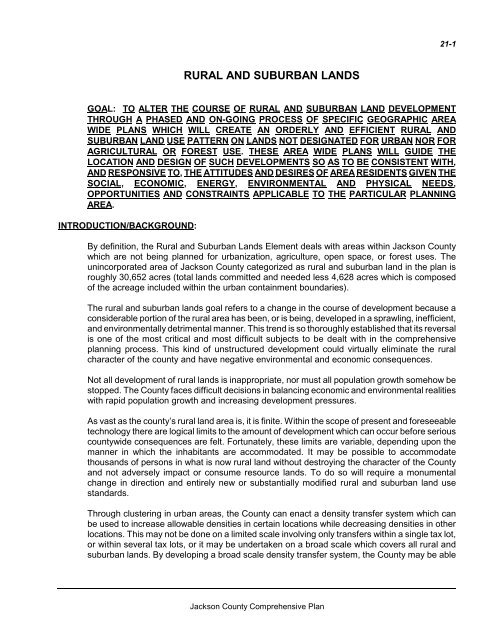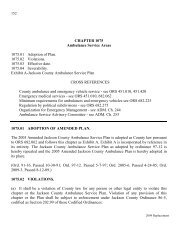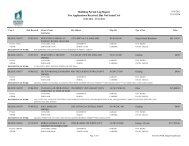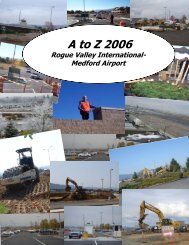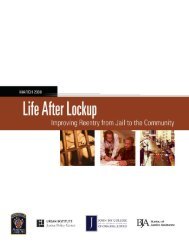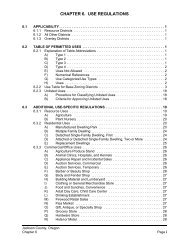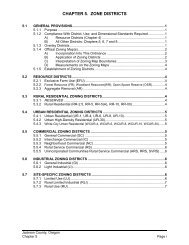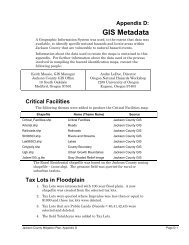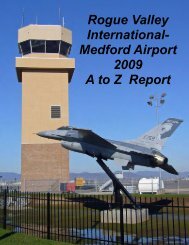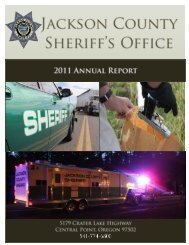RURAL AND SUBURBAN LANDS - Jackson County Oregon
RURAL AND SUBURBAN LANDS - Jackson County Oregon
RURAL AND SUBURBAN LANDS - Jackson County Oregon
You also want an ePaper? Increase the reach of your titles
YUMPU automatically turns print PDFs into web optimized ePapers that Google loves.
21-1<strong>RURAL</strong> <strong>AND</strong> <strong>SUBURBAN</strong> L<strong>AND</strong>SGOAL: TO ALTER THE COURSE OF <strong>RURAL</strong> <strong>AND</strong> <strong>SUBURBAN</strong> L<strong>AND</strong> DEVELOPMENTTHROUGH A PHASED <strong>AND</strong> ON-GOING PROCESS OF SPECIFIC GEOGRAPHIC AREAWIDE PLANS WHICH WILL CREATE AN ORDERLY <strong>AND</strong> EFFICIENT <strong>RURAL</strong> <strong>AND</strong><strong>SUBURBAN</strong> L<strong>AND</strong> USE PATTERN ON L<strong>AND</strong>S NOT DESIGNATED FOR URBAN NOR FORAGRICULTURAL OR FOREST USE. THESE AREA WIDE PLANS WILL GUIDE THELOCATION <strong>AND</strong> DESIGN OF SUCH DEVELOPMENTS SO AS TO BE CONSISTENT WITH,<strong>AND</strong> RESPONSIVE TO, THE ATTITUDES <strong>AND</strong> DESIRES OF AREA RESIDENTS GIVEN THESOCIAL, ECONOMIC, ENERGY, ENVIRONMENTAL <strong>AND</strong> PHYSICAL NEEDS,OPPORTUNITIES <strong>AND</strong> CONSTRAINTS APPLICABLE TO THE PARTICULAR PLANNINGAREA.INTRODUCTION/BACKGROUND:By definition, the Rural and Suburban Lands Element deals with areas within <strong>Jackson</strong> <strong>County</strong>which are not being planned for urbanization, agriculture, open space, or forest uses. Theunincorporated area of <strong>Jackson</strong> <strong>County</strong> categorized as rural and suburban land in the plan isroughly 30,652 acres (total lands committed and needed less 4,628 acres which is composedof the acreage included within the urban containment boundaries).The rural and suburban lands goal refers to a change in the course of development because aconsiderable portion of the rural area has been, or is being, developed in a sprawling, inefficient,and environmentally detrimental manner. This trend is so thoroughly established that its reversalis one of the most critical and most difficult subjects to be dealt with in the comprehensiveplanning process. This kind of unstructured development could virtually eliminate the ruralcharacter of the county and have negative environmental and economic consequences.Not all development of rural lands is inappropriate, nor must all population growth somehow bestopped. The <strong>County</strong> faces difficult decisions in balancing economic and environmental realitieswith rapid population growth and increasing development pressures.As vast as the county’s rural land area is, it is finite. Within the scope of present and foreseeabletechnology there are logical limits to the amount of development which can occur before seriouscountywide consequences are felt. Fortunately, these limits are variable, depending upon themanner in which the inhabitants are accommodated. It may be possible to accommodatethousands of persons in what is now rural land without destroying the character of the <strong>County</strong>and not adversely impact or consume resource lands. To do so will require a monumentalchange in direction and entirely new or substantially modified rural and suburban land usestandards.Through clustering in urban areas, the <strong>County</strong> can enact a density transfer system which canbe used to increase allowable densities in certain locations while decreasing densities in otherlocations. This may not be done on a limited scale involving only transfers within a single tax lot,or within several tax lots, or it may be undertaken on a broad scale which covers all rural andsuburban lands. By developing a broad scale density transfer system, the <strong>County</strong> may be able<strong>Jackson</strong> <strong>County</strong> Comprehensive Plan
Rural and Suburban Lands Element 21-2to reduce the density and intensity of development allowed in rural/suburban inappropriatelocations while increasing development in appropriate urban locations.Assuming that a broad scale density transfer system is implemented at some future time, the<strong>County</strong> must select appropriate locations for receiving the developments which are transferred.Transfers to areas within urban growth boundaries will be necessary, warranting closecooperation with participating cities.If the <strong>County</strong> is to achieve the goal for rural and suburban lands, it will do so through cautiousprovision of public facilities and through strong land use planning. A passive approach will clearlyallow suburban sprawl to become more widespread, wasting energy and further degrading airand water quality and diminishing the rural character in such areas.The Rural and Suburban Lands Element is strongly related to many other elements of thecomprehensive plan. This relationship is strongest with the agricultural, forest and urban landselements because of the locations of the lands involved; with the public facilities element andwith the housing element because residential developments can be expected to have the mostsignificant affect upon rural lands. Elements dealing with energy, transportation andenvironmental quality are also related.Development within the county’s rural and suburban lands includes a wide array of densities andintensities. Some areas have urban services such as sewer and water and are quite highly builtup.Note the existing industrial areas outside of Medford and Central Point urban growthboundaries. Other areas are already divided in to sprawling tracts of traditional block patternscontaining individual and scattered homesites of one to twenty acres. What this means is thatsome of nearly every conceivable type of conventional development already exists throughoutthe county and much of it is inappropriate in terms of public services, energy consumption andenvironmental impacts.The <strong>County</strong> clearly intends to stage the implementation of this element through a phasedplanning process, reflecting the above parameters and the policies and implementationstrategies stated herein. This phasing recognizes the diversity of the county’s lands andresources, the variety of social and economic attitudes, needs, capabilities and restraints, andlifestyles prevalent in the citizenry, as well as the energy, environmental and physicaldevelopment opportunities and constraints these factors present; and also, that planning is aprocess reflecting all of these influential aspects.FINDINGS, POLICIES <strong>AND</strong> IMPLEMENTATION STRATEGIES:1FINDING:Existing residential densities are low with the build-out having been constrained by poor soilconditions and lack of public facilities, but must be expected to show significant increases if notrestricted or redirected. It is not appropriate to assume that an area’s unsuitability for standardseptic systems will indefinitely prevent its development in an area where land use regulationsindicate that the area is appropriate for development, unless such development would be<strong>Jackson</strong> <strong>County</strong> Comprehensive Plan
Rural and Suburban Lands Element 21-3jeopardized by natural or man-induced hazards such as steep slopes, highly erosive or severesoil limitations, or would jeopardize the conservation of natural resources with high amenityvalues.Furthermore, the historic pattern of sprawling rural and suburban land use is well established insome areas. Considerable speculative investment has been made in rural lands and a highpercentage of rural residents intend to eventually divide their land and offer it for sale. The courtshave generally upheld downzoning actions in the interest of the public welfare withoutcompensation.POLICY: IT IS THE POLICY OF JACKSON COUNTY TO REDUCE <strong>AND</strong>REALLOCATE THE OVERALL ALLOWABLE DENSITY <strong>AND</strong> INTENSITY OF <strong>RURAL</strong><strong>AND</strong> <strong>SUBURBAN</strong> L<strong>AND</strong>S TO THE EXTENT NECESSARY TO MINIMIZE FURTHERDEGRADATION OF AIR QUALITY, REDUCE ENERGY CONSUMPTION <strong>AND</strong> REDUCETHE LONG-RANGE COST OF PROVIDING PUBLIC FACILITIES <strong>AND</strong> SERVICES.(NOTE: THE COUNTY CLEARLY INTENDS TO STAGE THE IMPLEMENTATION OFTHIS POLICY THROUGH A PHASED PLANNING PROCESS REFLECTING THEIMPLEMENTATION STRATEGIES NOTED BELOW. THIS PHASE SHALL COMMENCEIMMEDIATELY AFTER PLAN ACKNOWLEDGMENT BY LCDC <strong>AND</strong> IS EXPECTED TOBE IMPLEMENTED WITHIN ONE YEAR AFTER PLAN ACKNOWLEDGMENT.)IMPLEMENTATION STRATEGIES:A) Investigate a variety of alternative techniques which could be used to implementthe above policy and ensure goal achievement, and consider which areappropriate to the needs and desires of local area residents, including but notlimited to: downzoning, clustering/planned unit developments in urban areas,density transfer, upzoning, and other appropriate techniques as may be deemedfeasible and applicable. Any density/intensity increases will be emphasized inestablished communities and/or in areas which are already committed to suchdensities and uses through existing subdivisions, partitioning or development.B) Base all proposed rural and suburban land use and actions on the followingprinciples:i) Recognize the diversity of the county’s lands and natural resources andthe variety of social and economic needs, attitudes and life-stylesprevalent in the citizenry, as well as the overall social, economic, energy,environmental and physical opportunities and constraints these factorsinfluence regarding development in rural areas, and also that planning isa process responsible to these factors.ii)iii)Recognize the location and extent of existing rural and suburbanresidential development in areas where commitments to such uses anddensities have already been made .Development in such committed areas will be limited to the infilling ofvacant land at rural and suburban densities.<strong>Jackson</strong> <strong>County</strong> Comprehensive Plan
Rural and Suburban Lands Element 21-4iv)Rural and suburban lands and proposed developments beyond the areacited above will:a) Be appropriately, if not uniquely, suited to the area or siteproposed for such development;b) Promote an orderly and efficient rural and suburban land usepattern; and,c) Be located and designed so as to:* Preserve and enhance the rural character, naturalresources, scenic values and open spaces of the county;* Ensure the safety and viability of rural and suburban landsuses by limiting development in areas susceptible tonatural or man induced hazards;* Minimize the long-range public costs of providing facilitiesand services;* Provide an orderly transition between urban, suburbanand rural uses and areas;* Conserve natural resources with high amenity value;* Improve patterns of energy consumption; and,* Minimize the further degradation of air and water quality.2FINDING:The procedures required to develop a subdivision in <strong>Jackson</strong> <strong>County</strong>, and the types ofimprovements required, encourage many individuals to partition land rather than subdivide it.An astute team of developers can create as many as 27 new parcels from a single original lotin three years by partitioning. Such a development is not required to provide any improvementsand no permission from the <strong>County</strong> would be needed so long as minimal zoning requirementsare met. Another team of developers proposing to subdivide the same piece of property into 27lots would face public scrutiny, one or more hearings, and survey and improvement expenses,while facing the fact that the subdivision application could be denied.This double standard for subdivisions as opposed to partitions has a significant bearing uponpatterns of rural and suburban property divisions in <strong>Jackson</strong> <strong>County</strong>. Four to five times as manynew tracts are created by partitioning than by subdividing. The majority of rural and suburbanproperties are thus created without the types of improvements and overall design review<strong>Jackson</strong> <strong>County</strong> Comprehensive Plan
Rural and Suburban Lands Element 21-5appropriate for land development. Efforts to implement the policies of the Comprehensive Planby simply amending the subdivision ordinance without standards will have minimal effect uponrural and suburban areas where little of the property division activity is actually subdividing.3FINDING:POLICY: ALL L<strong>AND</strong> PARTITIONING SHALL BE DESIGNED TO MINIMIZE LONG-RANGE PUBLIC COSTS RESULTING FROM PROPERTY DIVISION ORDEVELOPMENT.IMPLEMENTATION STRATEGIES:A) Revise the subdivision ordinance to include requirements for major and minorpartitions. Improvement requirements for any property division should reduce thelikelihood of eventual high public costs for the provision of early repair orreplacement of public services and facilities.B) Modify the private road system of property divisions and require county or otherpublic roads to serve most divisions.C) Consider systems development charges and similar programs to minimize publiccosts resulting from development.Preexisting, nonconforming mobile home parks in rural and suburban areas will not automaticallydisappear as a result of any planning action. Some parks have received a poor reputation dueto inadequate planning during the original development stages or simply as a result of poorupkeep. Methods and techniques are available to upgrade the livability and general appearanceof existing parks through incentives in a manner which will not necessarily place an undueburden on the owner.POLICY: IT IS THE POLICY OF JACKSON COUNTY TO ENCOURAGE THEUPGRADING OF EXISTING MOBILE HOME PARKS TO CURRENT DEVELOPMENTST<strong>AND</strong>ARDS.IMPLEMENTATION STRATEGY: Existing mobile home parks which do not meetcurrent development standards or zone density, shall be encouraged to improve byallowing some expansion in trade for a general upgrading of the existing park. Reviseand amend the existing zoning and mobile home park ordinance to provide for increasedensities in mobile home parks, conforming to the above policy through a system oflimited density bonus or transfer subject to compliance with stringentdevelopment/improvement guidelines and criteria. Expansions should occur only onlands not considered as farm or forest. Specific criteria will be developed in conjunctionwith the revision of the applicable ordinances. Criteria would address spacing,landscaping, paving of streets, lighting, signing, storage, accessory buildings, provisionsfor community facilities and other aesthetic or functional characteristics of the park.<strong>Jackson</strong> <strong>County</strong> Comprehensive Plan
Rural and Suburban Lands Element 21-64FINDING:General Commercial: It is generally understood that most commercial development isconsidered to be urban in nature, and should therefore be limited to urban or urbanizable areas.The exceptions are those areas which are needed to serve the convenience needs of the ruralpopulation. Otherwise the expansion of commercial uses defeats the concept of encouragingurban centered growth; causes further sprawl; increases auto driving; affects air quality; and,potentially impacts rural resource land.The general commercial category of land use was originally created in 1972, to recognize thewide variety of light to heavy commercial activities that line some <strong>Jackson</strong> <strong>County</strong>’s statehighways. Frequently areas zoned for this use also contain uses which are industrial incharacter. Expansion of these areas generates many of the problems mentioned above. Theirsize is such, however, that they cannot be ignored. Making them nonconforming would alsodefeat the intent of good land use planning. They would not disappear, but only be hamperedin ability to expand or improve, and would eventually tend to become blighted due to neglect.On the other hand, careful access planning and site plan reviews on new fill-in developmentcould substantially improve the quality of these areas creating a more positive impact on theneighborhood in which they are located.5FINDING:POLICY: EXISTING COMMITTED GENERAL COMMERCIAL AREAS OUTSIDE OFURBAN GROWTH BOUNDARIES SHOULD NOT EXP<strong>AND</strong> EXCEPT FOR FILL-INDEVELOPMENT, <strong>AND</strong> WHERE POSSIBLE SHOULD BE UPGRADED, IMPROVINGAPPEARANCE, SAFETY <strong>AND</strong> NEIGHBORHOOD COMPATIBILITY.IMPLEMENTATION STRATEGY: The existing general commercial district should beapplied only to those areas that are considered to be generally committed to such usage.New areas not currently being used for this purpose should not be zoned for this type ofactivity.Rural Commercial Service Uses: Rural commercial service areas currently exist in numerouslocations throughout the county near concentrations of rural population. These centers servesome of the limited daily convenience needs of the rural resident, farming or forest community.Their scattered location in the rural areas saves driving time to larger urban business areas inaddition to being more energy efficient. These areas are generally limited in the type of serviceoffered due to the limited population that lives in the service area. Regardless, they should notbecome so large that they compete with business areas in nearby communities.<strong>Jackson</strong> <strong>County</strong> Comprehensive Plan
Rural and Suburban Lands Element 21-76FINDING:POLICY: <strong>RURAL</strong> SERVICE COMMERCIAL ACTIVITIES SHOULD BE PROVIDED INEASILY ACCESSIBLE LOCATION <strong>AND</strong> SIZED TO SERVE THE CONVENIENCENEEDS OF <strong>RURAL</strong> RESIDENTS.IMPLEMENTATION STRATEGIES:A) Maintain the existing rural service commercial zone district and limit the usespermitted only to those necessary to serve the limited commercial needs of ruralresidents.B) Zone only those areas actually deemed necessary, keeping in mind the need tomaintain the rural environment.Interchange Commercial Uses: Historically, the traveling public has been served by motels,restaurants, gas stations and similar uses located conveniently at freeway interchanges. Thetraveling public generally expects these conveniences.POLICY: SELECTED INTERCHANGE COMMERCIAL AREAS SHOULD BEALLOWED TO SERVE THE NEEDS OF THE TRAVELING PUBLIC AT FREEWAYINTERCHANGE AREAS IF THEY SATISFY THE FOLLOWING CRITERIA:A) THE USES DO NOT CONFLICT WITH ADJACENT CITY BUSINESS AREAS;B) ADJACENT L<strong>AND</strong> USES ARE BUFFERED FROM THE COMMERCIAL AREA;C) RESOURCE L<strong>AND</strong>S ARE NOT MATERIALLY AFFECTED BY THE USE;D) THE OPERATION <strong>AND</strong> EFFECTIVENESS OF THE INTERCHANGE IS NOTIMPACTED BY THE COMMERCIAL USE;E) THE USES CAN BE PROVIDED WITHOUT REQUIRING THE EXTENSION OFURBAN LEVEL SERVICES TO THE SITE.IMPLEMENTATION STRATEGY: Maintain the existing interchange commercial zoneand allow only those areas that generally would not compete with the other establishedbusiness districts.<strong>Jackson</strong> <strong>County</strong> Comprehensive Plan
Rural and Suburban Lands Element 21-87FINDING:Industrial Land Use: Throughout the unincorporated area of <strong>Jackson</strong> <strong>County</strong>, there exists a fewisolated locations and concentrations of existing industrial uses. Nearly all of these areas wereexisting prior to the adoption of countywide zoning and 1973. Many of these uses are consideredto be heavy industrial uses, such as wood products processing, manufacturing, or truckingrelated. White City, for example, has the largest acreage and concentration of industrial usesin <strong>Jackson</strong> <strong>County</strong>. Many of the uses that exist there require an extensive amount of land, andby their nature are best suited to a rural environment. Other industrial activities exist along someof <strong>Jackson</strong> <strong>County</strong>’s state highways, mixed in with existing commercial uses. These are foundon Highway 99, between Medford and Phoenix, and on Crater Lake Highway, between Medfordand White City.Like some commercial activities, most industrial development is considered to be urban innature, and should therefore, only occur within existing cities or urban growth boundaries.However, since industrial uses currently exist outside of cities and urban growth boundaries insubstantial quantity, it is necessary to recognize their existence; contain the development by onlyallowing fill-in development; and, provide standards to improve their use, appearance, and safetywhen possible.8FINDING:POLICY: EXISTING COMMITTED <strong>RURAL</strong> INDUSTRIAL AREAS OUTSIDE OFURBAN GROWTH BOUNDARIES SHOULD NOT BE EXP<strong>AND</strong>ED EXCEPT FOR FILL-IN DEVELOPMENT <strong>AND</strong> WHERE POSSIBLE, SHOULD BE UPGRADED, IMPROVINGAPPEARANCE, SAFETY <strong>AND</strong> NEIGHBORHOOD COMPATIBILITY.IMPLEMENTATION STRATEGIES:A) The existing light and heavy industrial zoning district should be applied only tothose areas that are considered to be generally committed to such usage. Newareas not currently being used for industrial use should not be zoned for futureindustrial use.B) Existing areas should be upgraded when possible, improving appearance, safetyand neighborhood compatibility. This could be accomplished through standardsin the zoning ordinance, or by applying a site plan review procedure to alldevelopment proposals.Limited Industrial and Commercial Uses: An extensive area of mixed residential, commercialand industrial use occurs in the vicinity of Table Rock Road, and the north side of the MedfordAirport. This area is in transition from residential to more intense use. Due to the nearness of<strong>Jackson</strong> <strong>County</strong> Comprehensive Plan
Rural and Suburban Lands Element 21-9commercial and industrial use tends to allow an option for the existing residential use that is lessimpacted by the airport. Additionally, some industrial uses may desire location near the airportfor the convenience and service it provides.POLICY: LIMITED INDUSTRIAL <strong>AND</strong> COMMERCIAL USES ARE DESIRED NEARTHE AIRPORT, IN THE AREA IMPACTED BY NOISE AS AN OPTION TO EXISTINGRESIDENTIAL USE, <strong>AND</strong> AS A MEANS TO SERVE SOME INDUSTRIES DESIRINGA LOCATION NEAR THE AIR TRANSPORTATION FACILITY.9IMPLEMENTATION STRATEGY: Maintain the existing mixed use and special usezoning categories in the zoning ordinance and apply the zone to lands impacted byairport noise.FINDING:Rural residential lands abut agricultural and forest lands in many locations throughout thecounty. conflicts are likely to result where rural residences are located in close proximity tointensive forestry, aggregate resource, or farming operations. Such conflicts may be mitigatedthrough various means including buffers but the most effective is physical separation. Due to theparticular economic importance of resource producing lands it is important that buffers beprovided on the less productive land, if possible, rather than consuming resource land for thatpurpose.10FINDING:POLICY: THE COUNTY SHALL MAINTAIN THE VIABILITY <strong>AND</strong> INTEGRITY OFRESOURCE L<strong>AND</strong>S BY PROVIDING BUFFER AREAS ON SPARSELY SETTLEDPROPERTIES ADJACENT TO SUCH RESOURCE L<strong>AND</strong>S.IMPLEMENTATION STRATEGIES:A) Amend zoning ordinance to indicate that agricultural, forestry, and mineralextraction operations may be considered the primary activities of rural areas eventhough residential uses may be permitted.B) Identify, through the areawide planning process, those sites whereresource/residence conflicts are likely to occur. This process should also be usedto analyze various methods of mitigating conflicts.Areawide Plans: Most of the <strong>Jackson</strong> <strong>County</strong> Comprehensive Plan addresses the applicationof state goals and planning policy on a countywide or issue related basis. As such, it mandatesuniformity throughout much of the county. It is recognized, however, that physically and socially<strong>Jackson</strong> <strong>County</strong> Comprehensive Plan
Rural and Suburban Lands Element 21-10many areas of the county differ. Where possible the Comprehensive Plan should have sufficientflexibility to fit the needs and attitudes of diverse areas as long as the general philosophy of thePlan and the requirements of the Statewide Planning Goals are not undermined.The concept of developing more detailed, more responsive area plans is a means to fine tunethe Comprehensive Plan after acknowledgment by the Land Conservation and DevelopmentCommission. As noted in the implementation strategies of many of the plan policies, detailedarea plans are suggested as a means to further study and resolve specific local issues, such asnoise, transportation, public facilities and services, specific land use conflicts, and similardetailed planning issues.POLICY: GREATER FLEXIBILITY <strong>AND</strong> DETAIL SHOULD ULTIMATELY BEPROVIDED WITHIN THE INTENT OF THE COMPREHENSIVE PLAN AS A MEANS TOREFLECT THE PHYSICAL <strong>AND</strong> SOCIAL VARIABLES <strong>AND</strong> ATTITUDES THAT EXISTTHROUGHOUT THE COUNTY.11IMPLEMENTATION STRATEGY: Develop a staged program of detail planning forindividual geographic areas of the county. The program would result in the eventualadoption of detailed area plans which would amend this comprehensive plan. This wouldbe based on the overall policies of the plan, yet adjusted to fit specific area’s needs ordesires.FINDING:Partitioning and Subdivision Activity: A major form of land development in the rural area of<strong>Jackson</strong> <strong>County</strong> occurs through a land partitioning and subdivision process. In 1979, there were247 minor partition applications, 23 major partition, and 6 subdivision requests. This createdapproximately 725 parcels during the year.In the rural areas this form of land use activity commits the land to its ultimate uses. The mannerin which this division of land occurs and the standards toward which the land is improved hasa long lasting effect on those occupying the land, and the general public, in terms of neededpublic facilities, services, maintenance, water quality, transportation, and others.Many of the policies of the Comprehensive Plan cannot be adequately implemented without thereview and control of land division in accordance with acceptable standards and guidelines.Partitioning and subdivision ordinances are authorized by <strong>Oregon</strong> Revised Statutes, Chapter 92.The <strong>County</strong> has had the subdivision ordinance since 1959; a major partition (private road)ordinance since 1975; and, a minor partition ordinance since 1979. The latter was adopted onlyas a means to apply the agriculture goal on an interim basis until adoption of the updatedComprehensive Plan.POLICY: THE COUNTY SHALL ESTABLISH <strong>AND</strong> MAINTAIN A L<strong>AND</strong> PAR-TITIONING <strong>AND</strong> SUBDIVISION ORDINANCE.<strong>Jackson</strong> <strong>County</strong> Comprehensive Plan
Rural and Suburban Lands Element 21-1112IMPLEMENTATION STRATEGY: The <strong>County</strong> shall update its partitioning andsubdivision ordinances as a means to implement numerous comprehensive plan policies.FINDING:Nonconforming Uses: Upon adoption of the 1973 zoning ordinance, numerous uses of landwere considered to be nonconforming, since the zone district applied did not permit someexisting uses. The updated plan and zoning may also create additional nonconforming uses.Nonconforming uses are generally considered to be undesirable or incompatible; incompatiblein the sense that they generate noise, dust, odor, traffic or other characteristics that maynegatively affect the neighborhood in which they are located.State law places limitations on nonconforming uses, and how they are handled locally. <strong>Oregon</strong>Revised Statutes 215.130 states as follows:“4) The lawful use of any building, structure or land at the time of the enactment oramendment of any zoning ordinance or regulation may be continued. Alteration of anysuch use may be permitted when necessary to reasonably continue the use withoutincrease and alteration of such use shall be permitted when necessary to comply withany lawful requirement for alteration in the use.”“5) Restoration of replacement of any use described in Subsection (4) of this sectionmay be permitted when the restoration is made necessary by fire, other casualty ornatural disaster. Restoration or replacement shall be commenced within one year fromthe occurrence of the fire, casualty, or natural disaster.”Many uses, currently considered to be nonconforming, may actually have limited negative impacton the neighborhood. Some of these uses provide rural employment opportunities for ruralresidents. Additionally, some of these uses, if expanded or altered, could, under proper siteplanning control, actually result in a mitigation of some of the potentially undesirable effects.Other uses are so obnoxious that they should not be expanded, with the view in mind that theywill someday be discontinued.POLICY: MOST NONCONFORMING USES SHOULD ULTIMATELY BE DIS-CONTINUED AS A MEANS TO IMPROVE THE QUALITY OF THE <strong>RURAL</strong>ENVIRONMENT. SOME NONCONFORMING USES, HOWEVER, WHICH ARE NOTIMPACTING THE <strong>RURAL</strong> ENVIRONMENT, SHOULD BE PERMITTED TO CONTINUE<strong>AND</strong> EVEN EXP<strong>AND</strong> IF EXISTING NEIGHBORHOOD IMPACTS ARE NOTINCREASED OR ARE IN PART MITIGATED.IMPLEMENTATION STRATEGIES:A) Require the discontinuation and altering of nonconforming uses as required byORS 215.130.<strong>Jackson</strong> <strong>County</strong> Comprehensive Plan
Rural and Suburban Lands Element 21-12B) During the areawide planning process evaluate in closer detail the types ofnonconforming uses in the area. If possible, categorize those which have limitedimpact on the neighborhood, and amend the zoning ordinance to make themconditional, thereby allowing expansion through a review and condition process.<strong>Jackson</strong> <strong>County</strong> Comprehensive Plan
Rural and Suburban Lands Element 21-13<strong>Jackson</strong> <strong>County</strong> Comprehensive Plan
Rural and Suburban Lands Element 21-14UNINCORPORATED COMMUNITIESAPPLEGATE <strong>RURAL</strong> COMMUNITY[Adopted by Ordinance #2000-6 on 4-24-00, Acknowledged by DLCD Order #001208 on 5-26-00,Effective 6-5-00. File #96-26-OA(PR)]The rural unincorporated community of Applegate is located in <strong>Jackson</strong> <strong>County</strong> approximately20 miles northwest of Medford along Highway 238. Applegate is centrally located in theApplegate River Valley, which continues into Josephine <strong>County</strong> and the unincorporatedcommunities of Wilderville and Murphy to the west. The Applegate river is a tributary of theRogue River. The population base of the Upper Applegate (including Ruch) is approximately3,870 people.The discovery of gold in the 1850's brought a flood of miners into the Applegate Valleywatershed. The Donation Land Claim Act of 1850 and the Homestead Act of 1860 encouragedeven greater numbers to settle in the area. In the mid-1850's, hostilities between thesenewcomers and the indigenous peoples of the Applegate watershed resulted in the decimationof Native American groups. Mining activities created a market for supplies which were broughtfirst on pack trains. The completion of the Crescent City to <strong>Jackson</strong>ville Wagon Road in 1858allowed freight wagons to supply the miners and made the area accessible to more people.As mining activities declined, agriculture and ranching became the economic mainstay of thearea. Grains, vegetables and fruits were grown; dairy herds, cattle and sheep grazed the area.Irrigation diversions, some of which had originated with mining operations, supported the finefamily farms of the area. People also engaged in some logging for local use. There was asawmill on Thompson Creek and another five miles west of Ruch. After World War II, there wasmore demand for lumber from the housing construction industry.In the 1950's, residents started seeing changes in their Applegate neighborhoods. The peoplewho were moving into the hills for a rural lifestyle had little interest in farming or ranching. Largerland holdings were divided into smaller homesite parcels. Hobby farms appeared, as did apattern of workers commuting to the nearby cities of Medford and Grants Pass. Land and homeproperty values rose, as the number of large, expensive homes increased. Homesites wereestablished on the upper valleys and hillsides.Today, the social and institutional setting of the Applegate watershed is remarkable for thedegree of formal collaboration and cooperation that exists around issues of environmentalconcern. The recent history of the area is one of local groups and federal agencies, namely theBureau of Land Management and the Forest Service, organizing around ecosystemmanagement, the stewardship of natural resources, and the mutual sustainability of the forests,economies, and communities of the Applegate.The community of Applegate has a rich history. It was originally named Bridge Point. Fromthere, travelers on the <strong>Jackson</strong>ville-Crescent City trail crossed the Applegate River via a woodenbridge built around 1860. A local farmer named Orlando Rose built a hall for dances andcommunity events near the crossing. The Bridge Point School District was organized in 1872and the Applegate Post Office opened in 1895. One of the first stores was owned by the Pernollfamily and built two miles west of the crossing in 1874. The Pernoll family later built a store at<strong>Jackson</strong> <strong>County</strong> Comprehensive Plan
Rural and Suburban Lands Element 21-15the crossing which housed the post office. Across the road from the Pernoll’s store, in 1947, theKubli family built a store with gas pumps and automobile service. Between their store and theriver, the Kublis made a park and picnic area, now called Applegate Wayside, close to the localswimming hole. Across the river from this site, one can still see the creamery building startedby the Werth family in 1912. The Valley Pride Creamery served the many area farmers who hadfresh milk and cream to be processed. It was operated until the late 1920's; today it serves asa private residence. Other community halls were built in the area, including Grubb Hall and theHerriott Community Hall, where dances and picnics were held. In 1946, the ApplegateCommunity Church was built on a hill overlooking the Pernoll store. The church originally hadties to the Assembly of God, but is now a non-denominational church.FINDINGS, POLICIES <strong>AND</strong> IMPLEMENTATION STRATEGIES:APPLEGATEA1FINDING: Growth must be based on current zoning and the availability of services. Ensure thatnew land uses are compatible with the existing environment, rather than establishing new usesthat require changes in the rural character of the Core. Proposals to change existing drainagepatterns, local loads and the highways, must be evaluated with respect to their affect upon therural character of the area.POLICY:COMMUNITY GROWTH SHOULD BE CONTROLLED, MANAGEDINTENTIONAL GROWTH.IMPLEMENTATION STRATEGY: A checklist will be developed to facilitate comment andapproval from the relevant county, federal and state agencies involved in issuance ofdevelopment permits of the community core area. Residential densities should be maintainedat the existing level, and new commercial uses should be kept at a rural scale with restrictionson height and square footage per development site. Specially designed Applegate Residentialand Applegate Rural Service Commercial Districts need to be adopted to guide developmentwithin the community core.APPLEGATEA2FINDING: Applegate residents expressed a need for greater communication between the<strong>County</strong> and residents on a variety of issues. Notice of land use decisions are made to propertyowners within a state mandated area. Residents expressed the need for more comprehensivenoticing, including non-traditional notice recipients, and public hearings on land use decisionsheld in the Applegate area.POLICY: FACILITATE CITIZEN PARTICIPATION <strong>AND</strong> COMMUNICATION BETWEENJACKSON COUNTY <strong>AND</strong> THE APPLEGATE RESIDENTS.IMPLEMENTATION STRATEGIES: To increase community involvement, <strong>Jackson</strong> <strong>County</strong> shall:Notify up to six community designated businesses or organizations of land use decisionson property within the Applegate core, or on property bordering the ApplegateCommunity Boundary. Organizations to be notified include the Applegator Newsletter,<strong>Jackson</strong> <strong>County</strong> Comprehensive Plan
Rural and Suburban Lands Element 21-16the Local Watershed Council, the local U.S. Post Office, any newly created CAC’s, theMedford Tribune and the Grants Pass Courier. Other organizations may be added to thelist only when one of the six organizations mentioned either ceases to exist or no longerwishes to receive notifications.Encourage Planning Commission and Board of Commissioners to hold their publichearings in the evening, in the Applegate Community on land use actions that will affectproperty inside or on property directly adjacent to the Applegate Community Boundary.Encourage <strong>Jackson</strong> <strong>County</strong> Hearings Officer to hold evening public hearings in theApplegate Community on all quasi-judicial land use actions on property within or directlyadjacent to the Applegate Community Boundary.APPLEGATEA3FINDING: Residents expressed concerns that Highway 238 would be widened and improved,thereby destroying the rural quality of life in their community. Residents felt that new land useswhich would require the expansion of existing transportation systems should not be allowed.POLICY: MAINTAIN THE CURRENT LEVEL OF TRANSPORTATION FACILITIES.IMPLEMENTATION STRATEGY: The <strong>County</strong> shall work with the <strong>Oregon</strong> Department ofTransportation to ensure that development within the Applegate Community Boundary will notresult in the need to add travel lanes or expand the existing highway. Additionally, the <strong>County</strong>will work with the <strong>Oregon</strong> Department of Transportation to ensure that the highway is safe,potentially reducing the speed limit in the Applegate Community Boundary.APPLEGATEA4FINDING: Applegate residents expressed concern about the future commercial developmentwithin their commercial core. Residents felt it was important to encourage, support and promotelocally owned businesses, while discouraging large commercial and industrial uses which arenot in keeping with the rural community environment. Special site design standards should bedeveloped for the Applegate Community Boundary to ensure that development maintains therural character of Applegate.POLICY: PROMOTE ECONOMIC DEVELOPMENT ACTIVITIES THAT ARE LOCALLYSUSTAINABLE <strong>AND</strong> SUPPORT A DISPERSED MODEL OF COMMERCIAL,AGRICULTURAL <strong>AND</strong>/OR INDUSTRIAL ACTIVITY.IMPLEMENTATION STRATEGY: Adopt a special Applegate rural Service Commercial Districtwhich will promote the rural commercial environment, allowing farmers’ markets and communitycommercial kitchens to further promote local businesses.<strong>Jackson</strong> <strong>County</strong> Comprehensive Plan
Rural and Suburban Lands Element 21-17APPLEGATEA5FINDING: Throughout the public meetings, Applegate residents expressed concerns over theneed for better protection of the natural environment, and the need for better coordinationbetween the <strong>County</strong>, State and Federal agencies responsible for protecting various aspects ofthe rural environment.POLICY: FOSTER LOCAL <strong>AND</strong> STATE SUPPORT FOR STEWARDSHIP OF THENATURAL ENVIRONMENT.IMPLEMENTATION STRATEGY: <strong>Jackson</strong> <strong>County</strong> shall work to better protect the 100 footriparian corridor along the Applegate River, thereby enhancing water quality, stormwater runoffand clearing activities. In the core area, existing public access to the Applegate River shouldbe maintained.FOOTS CREEK <strong>RURAL</strong> SERVICE CENTER[Adopted by Ordinance #97-23 on 7-9-97, Effective 9-8-97. File #97-5-OA]The service and residential areas of Foots Creek are located along Old Highway 99,approximately three miles south and east of the City of Rogue River. Early residents of the areawere miners and farmers, and the area was named for a prospector, O.G. Foot. Foots Creekcovers a large drainage area with its left, right and middle forks. According to Linda Genaw,author of Gold Hill and Its Neighbors Along The River (1988), there was a system of well-usedtrails among those forks that connected Foots Creek area residents, as well as other trails tonearby mining sites, including a shortcut to Forest Creek in the <strong>Jackson</strong>ville area, Galls Creekto the east, Birdseye Creek to the west, and Humbug Creek to the south. In 1882, a post officewas established on the middle fork at the store of Silas Draper. This post office functioned until1912. The lives of Foots Creek families were intertwined with those of Rock Point and Gold Hill.The era of steam-powered and then electric gold dredging kept the mining industry alive onFoots Creek up until World War II. The most recent aggregate activity took place during theconstruction of Interstate Highway 5, when the <strong>Oregon</strong> Department of Transportation (ODOT)installed a rock crusher on the left fork which was operated by <strong>Jackson</strong> <strong>County</strong>. Residentscontinue to be concerned about the potential for aggregate mining, crushing and batching onFoots Creek as evidenced by organized opposition in 1994 to a proposed aggregate site alongFoots Creek Road. While some farming continues on Foots Creek, most people commute tourban centers for work. In the past twenty years, the Foots Creek area has changed with moreand more vacant parcels being developed with residences.Today, the community consists of residentially developed parcels along the Rogue River andHighway 99; and, south throughout the Foots Creek drainage basin along Left Fork, Middle Forkand Right Fork Foots Creek Road. The community core includes one parcel, located along thesouthwest corner of Old Highway 99 and Foots Creek Road. The land use on this parcelincludes a general store, a deli, a small buy-sell trade operation, raft rentals, auto repair, cabinsfor rent and a residence.<strong>Jackson</strong> <strong>County</strong> Comprehensive Plan
Rural and Suburban Lands Element 21-18Based on the input from residents in the Foots Creek area, the parcel which is currently zonedRural Service and which has become known as the community core area, will be recognized asthe Rural Service Center. At this time, residents choose not to propose any changes in uses orintensity of uses. There are no changes proposed which would provide for increased residentialdensity or industrial uses.SAMS VALLEY <strong>RURAL</strong> SERVICE CENTER[Adopted by Ordinance #99-34 on 9-14-99, Acknowledged by DLCD Order #001102 on 10-14-99,Effective 10-24-99. File #97-10-OA(PR)]The rural service center of Sams Valley is located in <strong>Jackson</strong> <strong>County</strong>, approximately 11 milesnorth of Medford, at the junction of State Highway 234 and Antioch Road. The earliest settlersin the Valley were Enoch Pelton and Jose Sisemore who arrived in the early 1850s. They ownedvery large ranches in the area. The James Pankey family, arriving from Tennessee in the1950s, was another early settler family. The Pankey clan, bolstered by the arrival of John’s threebrothers and their families in the 1870s, had many children. Many of their progeny are buriedin the Pankey or Sams Valley cemetery.Andrew Moon settled in Sams Valley in the late 1850s. He was the “Founder of Moonville,” thefirst name of the Sams Valley community. Moon started a general store that also housed thedrug store of Arad Stanley, the famous local doctor. Apart from the general store and drugstore, there was a tinshop, as well as a blacksmith shop.The original plat for Sams Valley was along what is now called Old Sams Valley highway. Astore, school and post office formed the nucleus of the original hamlet. Old-timers indicate thatthe boundaries to Sams Valley are Ramsey Road to the west and Table Rock Road or MeadowsRoad to the east. The town was in its heyday in the 1880s. The rich farmland in the areaproduced food for the many miners who came to the Rogue River area. While some settlersfarmed in the summer and mined in the winter, there were many other miners who came withouttheir families to live in camps. These were dependent upon the produce, grains, livestock anddairy products produced nearby.The first school was Sams Creek School, established in 1861 in a log structure on Sams ValleyRoad. The next one was the Pankey school, begun in 1877. These schools were consolidatedto form one school district which, in 1951, consolidated with the Central Point School District.A newer school that forms part of that district, the Sams Valley Elementary School, is locatednear the intersection of Table Rock and Highway 234 and serves as a hub for the Sams Valleycommunity.Bypassed by the railroad in 1883, Sams Valley was eclipsed by the growth seven miles west inGold Hill which had a railroad depot. Gold Hill became the trading center for the area. Notablefamilies from the Sams Valley area were attracted by the business and banking activities in GoldHill. The merchant/druggist Stanley moved to Gold Hill and was, for many years, the Presidentof the City Council. The construction of the Gold Ray hydroelectric dam in the early 1900s onlyincreased the influence of Gold Hill in the region.<strong>Jackson</strong> <strong>County</strong> Comprehensive Plan
Rural and Suburban Lands Element 21-19To the northeast, the historic community of Beagle was Sam Valley’s closest neighbor. Thecommunity started near Meadows Road and continued eastward to the Dodge Bridge area; itsnorth/south boundaries ranged from Highway 234 up to Evans Creek Road. Little is left of thecommunity, for during World War II, Beagle and other lands to the east were purchased by thefederal government for purposes of constructing Camp White, a training camp for militarypersonnel. Vestiges from that era can still be seen near the intersection of Antioch and Highway234, where cattle graze among bunkers once used for artillery training.While Sams Valley is still dotted with large ranches, farms, and orchards, the number of workingfarms has decreased dramatically since those early days. Meanwhile, the number of residenceshas increased significantly and commuting to neighboring urban centers for work is common.The only commercial center in the Sams Valley area is now Rainey’s Corner. Located some 5miles to the east of the historic center of Sams Valley, Rainey’s Corner is much appreciated byconvenience shoppers. According to old-time residents, the commercial area at the intersectionof Antioch and Highway 234 was first established in the 1960s, when it was called Pruitt Junctionafter the owner. When it changed hands, it took the name of a new owner. More recently, it hasbecome known as Rainey’s Corner since current owner Michael Rainey bought the property.While the Sams Valley Rural Service Commercial District represents an area where businessopportunities can continue and grow in order to provide services to the surrounding residents,the heart of the community is represented by area residents.The community is a much larger area than what the Unincorporated Communities Rule identifies.The actual community area encompasses the whole of Sams Valley.The community recognizes that the Sams Valley Rural Service Commercial District is locatedat the corner of Highway 234 and Antioch Road, it would like to state that the historical SamsValley is located on Meadows Road.POLICIES <strong>AND</strong> IMPLEMENTATION STRATEGIES:SV1FINDING: Sams Valley residents have expressed a need to create a Citizens AdvisoryCommittee which will be notified of all major land use actions and a need for greatercommunitcation between the county and residents on a variety of issues. Notice of land usedecisions are made to property owners within state mandated areas. Residents expressed theneed for more comprehensive noticing, including non-traditional notice recipients, and publichearings on land use decisions held in the Sams Valley area.POLICY : Increase citizen participation in land use planning.IMPLEMENTATION STRATEGY: Create a Sams Valley Citizen’s Advisory Committee whichwill represent the Sams Valley region in land use decisions.IMPLEMENTATION STRATEGY: <strong>Jackson</strong> <strong>County</strong> Planning and Development Services shallsend notifications of major land use actions within the Sams Valley area to the newly created<strong>Jackson</strong> <strong>County</strong> Comprehensive Plan
Rural and Suburban Lands Element 21-20Sams Valley Citizen’s Advisory Committee, Rainey’s Market, Sweet’s General Store, and theTriple Tree Restaurant.IMPLEMENTATION STRATEGY: Request the <strong>County</strong> Planning Commission and the Board ofCommissioners to hold public evening hearings in Sams Valley on major land use actions beforethem that affect property within the Sams Valley area.IMPLEMENTATION STRATEGY: Funds for reviewing and amending the Sams Valley plan maybe requested by the Sams Valley Citizen’s Advisory Committee from the Department of LandConservation and Development, the <strong>Oregon</strong> Economic Development Department and otheragencies.SV2FINDING: Sams Valley residents expressed concerns about the water resources within thearea.POLICY: The Community recognizes the need to protect all water resources.IMPLEMENTATION STRATEGY: The community will work with the <strong>County</strong> Commissioners andWater Resources Department to obtain hydrological information regarding our water supplies.IMPLEMENTATION STRATEGY: As information on our water supplies is obtained, thatinformation will guide <strong>County</strong> decision-making regarding the approval of additional developmentin the Sams Valley area.IMPLEMENTATION STRATEGY: The Community will work with the Board of Commissionersand the Health Department to explore the possibility of the development of a community watersystem.SV3FINDING: Growth must be based on the current zoning and the availability of services. Insurethe rural character by maintaining and protecting the resource lands that surround the core area.POLICY: Enhance and preserve the rural character of Sams Valley.IMPLEMENTATION STRATEGY: The community will endeavor to make planning decisions thatrespect and retain the rural character of the area.IMPLEMENTATION STRATEGY: Maintain existing rural densities.SV4FINDING: Residents of Sams Valley expressed concerns about traffic safety.<strong>Jackson</strong> <strong>County</strong> Comprehensive Plan
Rural and Suburban Lands Element 21-21POLICY: Ensure the safety of our transportation facilities.IMPLEMENTATION STRATEGY: Work with the <strong>Oregon</strong> Department of Transportation and thecounty to insure that public thoroughfares are safe.IMPLEMENTATION STRATEGY: The Citizen Advisory Committee will establish asubcommittee to work on road improvements in the Sams Valley area.SV5FINDING: The community expressed concerns about long-range planning.POLICY: The community of Sams Valley will communicate with <strong>Jackson</strong> <strong>County</strong> aboutcurrent and long-range planning issues.IMPLEMENTATION STRATEGY: Encourage the State and the <strong>County</strong> to enact regulations thatsimplify the land use application process and ensure equal access and opportunity, by suchmeans as redicing fees and using language intelligible to laymen.IMPLEMENTATION STRATEGY: With the assistance of the <strong>County</strong>, the community wishes toreinforce its identity as Sams Valley through the creation of a local post office substation and zipcode for the area.IMPLEMENTATION STRATEGY: The community will explore opportunities for an irrigationproject in the Sams Valley area to ensure Sams Valley’s future as farmland in the Rogue Valley.IMPLEMENTATION STRATEGY: The community will work with the Public Utility Commissionto have local telephone access within the Sams Valley area.SAVAGE CREEK <strong>RURAL</strong> SERVICE CENTER[Adopted by Ordinance #97-5 on 3-19-97, Effective 5-19-97. File #97-1-OA]The service and residential areas of Savage Creek are located along Highway 99 on the southside of the Rogue River. This area, along with Savage Rapids on the Rogue River in Josephine<strong>County</strong>, was named for a pioneer settler. James Savage came to <strong>Oregon</strong> from Illinois in 1853and took up a donation land claim near the geographic features that now bear his name. Thecommunity consists of more than a 100 dwelling units spread through the Savage Creekdrainage and along the highway on lots ranging in size from approximately .3 to 40 acres. Thecity of Rogue River is approximately 2 miles to the east and Grants Pass is approximately 10miles to the west along the Rogue River. The services in the community core area consist ofa boat ramp and river park between the highway and the Rogue River at the confluence ofSavage Creek and the Rogue River. Across from this park, south of the highway, are a tavern,a motel, a hair salon and an automotive repair. There is also some vacant office space and asmall seasonal grocery store.<strong>Jackson</strong> <strong>County</strong> Comprehensive Plan
Rural and Suburban Lands Element 21-22Based on the input from residents in the Savage Creek area, those parcels which are currentlyzoned Rural Service and which have become known as the community core area, will berecognized as the Rural Service Center. At this time, residents chose not to propose anychanges in uses or intensity of uses. There are no changes proposed which would provide forincreased residential density or industrial uses.TRAIL <strong>RURAL</strong> SERVICE CENTER[Adopted by Ordinance #97-3 on 3-19-97, Effective 5-19-97. File #97-2-OA]The rural service center of Trail is located in <strong>Jackson</strong> <strong>County</strong>, approximately 21 miles north ofMedford. Trail is located between Shady Cove and Prospect, at the junction of State Highway62 and State Highway 227. Local historian Barbara Hegne poetically describes the beginningsof the community of Trail: “An Indian path followed a rushing creek down the mountain, from theUmpqua divide, till it emptied into the Rogue River. From the late 1870's, to the early 1900's,settlers homesteaded on the banks of this creek, and they named it Trail.” (Yonder Hills.1989:64.) Existing services in the community of Trail consist of a post office, a tavern and agrocery store on Highway 62. The central core of Trail is defined by land inside of a trianglecreated by Highway 62, Old Highway 227, Highway 227 and Old Trail Creek Road. There arealso 2 residences within this triangle and a mobile home park with 7 mobile homes and 2houses. The zoning in this triangle is a Rural Service Commercial (RS) zone. Three otherhomes border this core on separate properties. Community members are spread out on RuralResidential (RR-5 zone) and resource parcels [either Woodland Resource (WR) , Open SpaceReserve (OSR) or Exclusive Farm Use (EFU)] along each of the major roads already identifiedas well as Ragsdale Road which travels south and east off of the Trail Creek Road. Anelementary school and other commercial services of restaurants, lodging and stores exist in theRogue Elk neighborhood.Based on the input from the residents in the Trail area, those parcels which are currently zonedRural Service Commercial and which have become known as the community core area, will berecognized as the Rural Service Center. At this time, residents chose not to propose anychanges in uses or intensity of uses. There are no changes proposed which would provide forincreased residential density or industrial uses.<strong>Jackson</strong> <strong>County</strong> Comprehensive Plan


